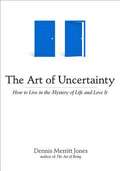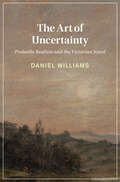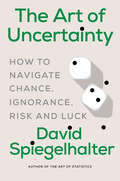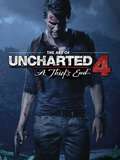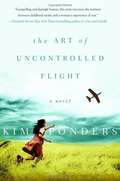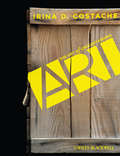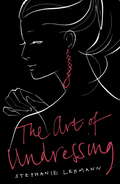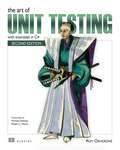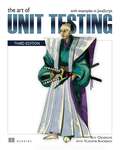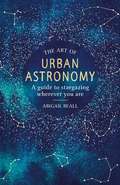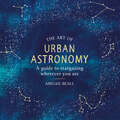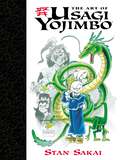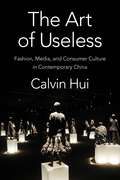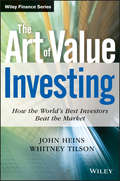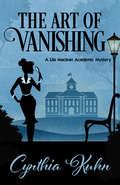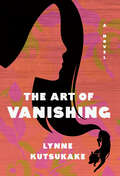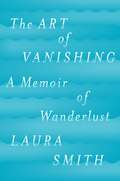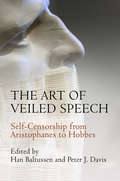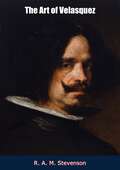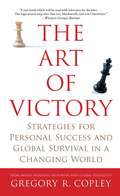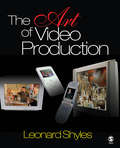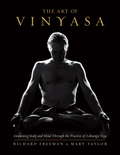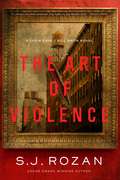- Table View
- List View
The Art of Uncertainty: How to Live in the Mystery of Life and Love It
by Dennis Merritt JonesWhat if we could learn to accept I don't know and embrace the possibility that the future is full of mystery, excitement, and unlimited opportunity? The Art of Uncertainty is an invitation to the reader to consider its essential message: learning to love the unknown by staying present in the moment. If the difficulties of recent years have taught us anything-particularly those who "did everything right" and still saw it all fall apart-it's that none of us has as much control over our lives as we believe. The only thing we can control is our next thought. What if we could learn how to be at peace with uncertainty and embrace the possibility that the future is full of mystery, excitement, and unlimited opportunity? What if we discovered that a new paradigm can be more fulfilling, more rewarding, and more peaceful than what we have known? Living in the I don't know and loving it is an art form we can all master, and The Art of Uncertainty is the perfect guidebook.
The Art of Uncertainty: Probable Realism and the Victorian Novel (Cambridge Studies in Nineteenth-Century Literature and Culture)
by Daniel WilliamsThe Victorian novel developed unique forms of reasoning under uncertainty-of thinking, judging, and acting in the face of partial knowledge and unclear outcome. George Eliot, Wilkie Collins, William Thackeray, Thomas Hardy, and later Joseph Conrad drew on science, mathematics, philosophy, and the law to articulate a phenomenology of uncertainty against emergent models of prediction and decision-making. In imaginative explorations of unsure reasoning, hesitant judgment, and makeshift action, these novelists cultivated distinctive responses to uncertainty as intellectual concern and cultural disposition, participating in the knowledge work of an era shaped by numerical approaches to the future. Reading for uncertainty yields a rich account of the dynamics of thinking and acting, a fresh understanding of realism as a genre of the probable, and a vision of literary-critical judgment as provisional and open-ended. Daniel Williams spotlights the value of literary art in a present marked by models and technologies of prediction.
The Art of Uncertainty: How to Navigate Chance, Ignorance, Risk and Luck
by David SpiegelhalterNamed a Best Book of the Year by Forbes and The Economist From our "greatest living statistical communicator" (Tim Harford) comes an invaluable, data-driven guide for understanding—and learning to embrace—risk and uncertainty in our daily lives. How dangerous is our diet? How much of sports falls into the realm of luck? When authorities categorize a given event as “highly likely”—how likely is that, really? Whether we’re trying to decide if the benefits of a new medication are worth the chance of side effects or if artificial intelligence truly threatens humanity, our lives are riddled with uncertainties both everyday and existential—yet it can be difficult to know how to properly weigh all those unknowns. Luckily for us, renowned statistician David Spiegelhalter has spent his career dissecting data to resolve the apparently random and decode the many decisions we face with imperfect information. In The Art of Uncertainty, he shows how we can become better at dealing with what we don’t know to make smarter choices in a world so full of puzzling variables. In lucid, lively prose, Spiegelhalter guides us through the principles of probability, illustrating how they can help us think more analytically about everything from medical advice to sports to climate change forecasts. He demonstrates how taking a mathematical approach to phenomena we might otherwise attribute to fate or luck can help us sort hidden patterns from mere coincidences, better evaluate cause and effect, and predict what’s likely to happen in the future. Along the way, we learn how a misinterpretation of a probability contributed to the infamous Bay of Pigs fiasco, why a ship twice the size of the Titanic sank without a trace, and why we can be so confident that no two properly shuffled decks of cards have ever been in the same order. Sparkling with wit and fascinating real-world examples, this is an essential guide to navigating uncertainty while also retaining the humility to admit what we don’t, or simply cannot, know.
The Art of Uncharted 4: A Thief's End
by VariousJourney alongside Nathan Drake once again, as Naughty Dog and Dark Horse Books team up to bring you this comprehensive and breathtaking exploration into Uncharted 4: A Thief's End! Numerous never-before-seen designs and concept art accompanied by commentary from the developers give you behind-the-scenes access to the creation of this gaming masterwork. This beautiful oversized hardcover is a must-have for any fan of the Uncharted franchise and high quality video game art.The Art of Unchartend 4 will be released by Dark Horse simultaneoulsy with the new game, Uncharted 4.
The Art of Uncontrolled Flight
by Kim PondersThe long shadow of a charismatic father leads Annie Shaw to decide, as far back as she can remember, to follow in his footsteps and become an Air Force pilot. Years later, after her mother's death and her own graduation from the academy, Captain A. Shaw is now one of the first female pilots in American history to engage in active combat duty during the first Gulf War. But her pride at earning rank as the only woman in an all-male fraternity offers little solace as the realities of battle change her, forever, into a wary, combat-wise survivor.
The Art of Understanding Art
by Irina D. CostacheThe Art of Understanding Art reveals to students and other readers new and meaningful ways of developing personal ideas and opinions about art and how to express them with confidence. Offers an inquiry--unique among introductory art texts--into the learning process of understanding and appreciating art Examines the multiple issues and processes essential to making, analyzing and evaluating art Uses cross-cultural examples to help readers develop comprehensive, yet personal, ways of looking at and thinking about art Includes an annotated glossary of the 'Art World', institutions and individuals that play a role in defining art as well as diagrams, textboxes callouts and other visual elements to highlight information and enhance learning Richly illustrated with over 40 images Suggests innovative class assignments and projects useful for developing lesson plans, and offers an online companion site for additional illustrations and information
The Art of Undressing
by Stephanie LehmannGinger Levine really doesn't want to turn into her mother. Coco used to be an exotic dancer and now makes her living selling sex toys and teaching the Fine Art of Striptease. A straitlaced twenty-five-year-old would-be pastry chef, Ginger has no desire to follow in her mum's high-heeled footsteps.But when she falls for a fellow student, she finds herself ill-equipped in the art of seduction. And suddenly she's looking for some motherly advice on how to reveal herself to the man she loves . . .
The Art of Unit Testing: with examples in C#
by Roy OsheroveSummaryThe Art of Unit Testing, Second Edition guides you step by step from writing your first simple tests to developing robust test sets that are maintainable, readable, and trustworthy. You'll master the foundational ideas and quickly move to high-value subjects like mocks, stubs, and isolation, including frameworks such as Moq, FakeItEasy, and Typemock Isolator. You'll explore test patterns and organization, working with legacy code, and even "untestable" code. Along the way, you'll learn about integration testing and techniques and tools for testing databases and other technologies.About this BookYou know you should be unit testing, so why aren't you doing it? If you're new to unit testing, if you find unit testing tedious, or if you're just not getting enough payoff for the effort you put into it, keep reading.The Art of Unit Testing, Second Edition guides you step by step from writing your first simple unit tests to building complete test sets that are maintainable, readable, and trustworthy. You'll move quickly to more complicated subjects like mocks and stubs, while learning to use isolation (mocking) frameworks like Moq, FakeItEasy, and Typemock Isolator. You'll explore test patterns and organization, refactor code applications, and learn how to test "untestable" code. Along the way, you'll learn about integration testing and techniques for testing with databases.The examples in the book use C#, but will benefit anyone using a statically typed language such as Java or C++.Purchase of the print book includes a free eBook in PDF, Kindle, and ePub formats from Manning Publications.What's InsideCreate readable, maintainable, trustworthy testsFakes, stubs, mock objects, and isolation (mocking) frameworksSimple dependency injection techniquesRefactoring legacy codeAbout the AuthorRoy Osherove has been coding for over 15 years, and he consults and trains teams worldwide on the gentle art of unit testing and test-driven development. His blog is at ArtOfUnitTesting.com.Table of ContentsPART 1 GETTING STARTEDThe basics of unit testingA first unit testPART 2 CORE TECHNIQUESUsing stubs to break dependenciesInteraction testing using mock objectsIsolation (mocking) frameworksDigging deeper into isolation frameworksPART 3 THE TEST CODETest hierarchies and organizationThe pillars of good unit testsPART 4 DESIGN AND PROCESSIntegrating unit testing into the organizationWorking with legacy code Design and testability
The Art of Unit Testing, Third Edition: with examples in JavaScript (The Art of)
by Roy OsheroveUnit testing is more than just a collection of tools and practices—it&’s a state of mind! This bestseller reveals the master&’s secrets for delivering robust, maintainable, and trustworthy code.Thousands of developers have learned to hone their code quality under the tutelage of The Art of Unit Testing. This revised third edition updates an international bestseller to reflect modern development tools and practices, as well as to cover JavaScript. Inside The Art of Unit Testing, Third Edition you will learn how to: Create readable, maintainable, and trustworthy tests Work with fakes, stubs, mock objects, and isolation frameworks Apply simple dependency injection techniques Refactor legacy code with confidence Test both frontend and backend code Effective unit tests streamline your software development process and ensure you deliver consistent high-quality code every time. With practical examples in JavaScript and Node, this hands-on guide takes you from your very first unit tests all the way to comprehensive test suites, naming standards, and refactoring techniques. You&’ll explore test patterns and organization, working with legacy code and even &“untestable&” code. The many tool-agnostic examples are presented in JavaScript and carefully designed so that they apply to code written in any language. About the technology The art of unit testing is more than just learning the right collection of tools and practices. It&’s about understanding what makes great tests tick, finding the right strategy for each unique situation, and knowing what to do when the testing process gets messy. This book delivers insights and advice that will transform the way you test your software. About the book The Art of Unit Testing, Third Edition shows you how to create readable and maintainable tests. It goes well beyond basic test creation into organization-wide test strategies, troubleshooting, working with legacy code, and &“merciless&” refactoring. You&’ll love the practical examples and familiar scenarios that make testing come alive as you read. This third edition has been updated with techniques specific to object-oriented, functional, and modular coding styles. The examples use JavaScript. What's inside Deciding on test types and strategies Test Entry & Exit Points Refactoring legacy code Fakes, stubs, mock objects, and isolation frameworks Object-Oriented, Functional, and Modular testing styles About the reader Examples use JavaScript, TypeScript, and Node.js. About the author Roy Osherove is an internationally-recognized expert in unit testing and agile software methodology. Vladimir Khorikov is the author of Manning&’s Unit Testing Principles, Practices, and Patterns, a Pluralsight author, and a Microsoft MVP. Table of Contents PART 1 1 The basics of unit testing 2 A first unit test PART 2 3 Breaking dependencies with stubs 4 Interaction testing using mock objects 5 Isolation frameworks 6 Unit testing asynchronous code PART 3 7 Trustworthy tests 8 Maintainability PART 4 9 Readability 10 Developing a testing strategy 11 Integrating unit testing into the organization 12 Working with legacy code Appendix Monkey-patching functions and modules
The Art of Urban Astronomy: A Guide to Stargazing Wherever You Are
by Abigail BeallDid you know that stars are seasonal? That Orion is one of the brightest constellations? That a single day on Venus is longer than an entire year on Venus? Space has captivated mankind since the beginning of time. Fifty years ago, Neil Armstrong became the first man to step on the moon and since then our knowledge of astronomy has continued to expand. With so many mysteries yet to be solved, science journalist Abigail Beall takes readers on an astonishing journey though the landscape of space. In The Art of Urban Astronomy, you will be guided through the seasons and learn about the brightest stars and constellations, the myths and legends of astronomy and how to identify star clusters and galaxies with just your eyes or a pair of binoculars. For urban dwellers wrapped up in the rush and bustle of the city, it can be calming and truly valuable to take the time simply to stop, look and reconnect with nature. Packed full of seasonal star charts, constellation charts and fascinating facts, this is the perfect guide for those who have looked up at the night sky and don't know where to begin. After reading this book, you'll never look up in the same way again.
The Art of Urban Astronomy: A Guide to Stargazing Wherever You Are
by Abigail BeallDid you know that stars are seasonal? That Orion is one of the brightest constellations? That a single day on Venus is longer than an entire year on Venus? Space has captivated mankind since the beginning of time. Fifty years ago, Neil Armstrong became the first man to step on the moon and since then our knowledge of astronomy has continued to expand. With so many mysteries yet to be solved, science journalist Abigail Beall takes readers on an astonishing journey though the landscape of space. In The Art of Urban Astronomy, you will be guided through the seasons and learn about the brightest stars and constellations, the myths and legends of astronomy and how to identify star clusters and galaxies with just your eyes or a pair of binoculars. For urban dwellers wrapped up in the rush and bustle of the city, it can be calming and truly valuable to take the time simply to stop, look and reconnect with nature. Packed full of seasonal star charts, constellation charts and fascinating facts, this is the perfect guide for those who have looked up at the night sky and don't know where to begin. After reading this book, you'll never look up in the same way again.
The Art of Urban Astronomy: A Guide to Stargazing Wherever You Are
by Abigail BeallDid you know that stars are seasonal? That Orion is one of the brightest constellations? That a single day on Venus is longer than an entire year on Venus? Space has captivated mankind since the beginning of time. Fifty years ago, Neil Armstrong became the first man to step on the moon and since then our knowledge of astronomy has continued to expand. With so many mysteries yet to be solved, science journalist Abigail Beall takes readers on an astonishing journey though the landscape of space. In The Art of Urban Astronomy, you will be guided through the seasons and learn about the brightest stars and constellations, the myths and legends of astronomy and how to identify star clusters and galaxies with just your eyes or a pair of binoculars. For urban dwellers wrapped up in the rush and bustle of the city, it can be calming and truly valuable to take the time simply to stop, look and reconnect with nature. Packed full of seasonal star charts, constellation charts and fascinating facts, this is the perfect guide for those who have looked up at the night sky and don't know where to begin. After reading this book, you'll never look up in the same way again.
Art of Usagi Yojimbo
by Stan SakaiIn the tradition of the celebrated collections The Art of Sin Cityand The Art of Hellboy, Dark Horse is proud to showcase the work of multi award-winning creator Stan Sakai in The Art of Usagi Yojimbo. The sold-out hardcover edition, timed to coincide with the twentieth anniversary of the creation of Sakai's signature character, Usagi Yojimbo, was met with an overwhelming response from thousands of fans around the world. This edition features scores of never-before-seen pieces, a long out-of-print twelve-page primer illustrating how Stan creates each of his Usagi stories, forty-eight full-color pages of Stan's beautiful painted artwork, and more. Additionally, some of the biggest names in comics pay tribute to their favorite rabbit ronin in a fantastic gallery section, with pinups by Frank Miller, Geof Darrow, Jeff Smith, Sergio Aragonés, and Matt Wagner, among others!
The Art of Useless: Fashion, Media, and Consumer Culture in Contemporary China (Global Chinese Culture)
by Calvin HuiSince embarking on economic reforms in 1978, the People’s Republic of China has also undergone a sweeping cultural reorganization, from proletarian culture under Mao to middle-class consumer culture today. Under these circumstances, how has a Chinese middle class come into being, and how has consumerism become the dominant ideology of an avowedly socialist country? The Art of Useless offers an innovative way to understand China’s unprecedented political-economic, social, and cultural transformations, showing how consumer culture helps anticipate, produce, and shape a new middle-class subjectivity.Examining changing representations of the production and consumption of fashion in documentaries and films, Calvin Hui traces how culture contributes to China’s changing social relations through the cultivation of new identities and sensibilities. He explores the commodity chain of fashion on a transnational scale, from production to consumption to disposal, as well as media portrayals of the intersections of clothing with class, gender, and ethnicity. Hui illuminates key cinematic narratives, such as a factory worker’s desire for a high-quality suit in the 1960s, an intellectual’s longing for fashionable clothes in the 1980s, and a white-collar woman’s craving for brand-name commodities in the 2000s. He considers how documentary films depict the undersides of consumption—exploited laborers who fantasize about the products they manufacture as well as the accumulation of waste and its disposal—revealing how global capitalism renders migrant factory workers, scavengers, and garbage invisible.A highly interdisciplinary work that combines theoretical nuance with masterful close analyses, The Art of Useless is an innovative rethinking of the emergence of China’s middle-class consumer culture.
The Art of Value Investing
by John Heins Whitney TilsonSays Bill Ackman of Pershing Square Capital Management about The Art of Value Investing: "I learned the investment business largely from the work and thinking of other investors. The Art of Value Investing is a thoughtfully organized compilation of some of the best investment insights I have ever read. Read this book with care. It will be one of the highest-return investments you will ever make. " Based on interviews with the world's most-successful value investors, The Art of Value Investing offers a comprehensive set of answers to the questions every equity money manager should have thought through clearly before holding himself or herself out as a worthy steward of other people's money. What market inefficiencies will I try to exploit? How will I generate ideas? What will be my geographic focus? What analytical edge will I hope to have? What valuation methodologies will I use? What time horizon will I typically employ? How many stocks will I own? How specifically will I decide to buy or sell? Will I hedge, and how? How will I keep my emotions from getting the best of me? Who should read The Art of Value Investing? It is as vital a resource for the just starting out investor as for the sophisticated professional one. The former will find a comprehensive guidebook for defining a sound investment strategy from A-to-Z; the latter will find all aspects of his or her existing practice challenged or reconfirmed by the provocative thinking of their most-successful peers. It also is a must read for any investor - institutional or individual - charged with choosing the best managers for the money they are allocating to equities. Choosing the right managers requires knowing all the right questions to ask as well as the answers worthy of respect and attention - both of which are delivered in The Art of Value Investing.
The Art of Vanishing (A Lila Maclean Academic Mystery #2)
by Cynthia KuhnA quirky mystery set in “the treacherous world of academia—seething with manipulation, jealousy, and relentless ambition. A terrific plot.” —Hank Phillippi Ryan, Mary Higgins Clark Award–winning author of Trust Me A Lefty Award Nominee for Best Humorous Mystery When Professor Lila Maclean is sent to interview celebrated author and notorious cad Damon Von Tussel, he disappears before her very eyes. The English department is thrown into chaos by the news, as Damon is supposed to headline Stonedale University’s upcoming Arts Week. The chancellor makes it clear that he expects Lila to locate the writer and set events back on track immediately. But someone appears to have a different plan: Strange warnings are received, valuable items go missing, and a series of dangerous incidents threaten the lives of Stonedale’s guests. After her beloved mother, who happens to be Damon’s ex, rushes onto campus and into harm’s way, Lila has even more reason to bring the culprit to light before anything—or anyone—else vanishes. This mystery in the Agatha Award–winning series is “tightly plotted with a deliciously memorable cast of characters . . . Kuhn’s smart sense of humor made every page a pleasure” (Marla Cooper, author of the Kelsey McKenna Destination Wedding Mysteries). “Whether Stonedale University English professor Lila is confronting a backstabbing colleague or investigating a murder attempt on a cantankerous bestselling author, readers will root for this enormously likeable heroine.” —Ellen Byron, USA Today–bestselling author of Plantation Shudders
The Art of Vanishing (A Lila Maclean Academic Mystery #2)
by Cynthia KuhnA quirky mystery set in “the treacherous world of academia—seething with manipulation, jealousy, and relentless ambition. A terrific plot.” —Hank Phillippi Ryan, Mary Higgins Clark Award–winning author of Trust Me A Lefty Award Nominee for Best Humorous Mystery When Professor Lila Maclean is sent to interview celebrated author and notorious cad Damon Von Tussel, he disappears before her very eyes. The English department is thrown into chaos by the news, as Damon is supposed to headline Stonedale University’s upcoming Arts Week. The chancellor makes it clear that he expects Lila to locate the writer and set events back on track immediately. But someone appears to have a different plan: Strange warnings are received, valuable items go missing, and a series of dangerous incidents threaten the lives of Stonedale’s guests. After her beloved mother, who happens to be Damon’s ex, rushes onto campus and into harm’s way, Lila has even more reason to bring the culprit to light before anything—or anyone—else vanishes. This mystery in the Agatha Award–winning series is “tightly plotted with a deliciously memorable cast of characters . . . Kuhn’s smart sense of humor made every page a pleasure” (Marla Cooper, author of the Kelsey McKenna Destination Wedding Mysteries). “Whether Stonedale University English professor Lila is confronting a backstabbing colleague or investigating a murder attempt on a cantankerous bestselling author, readers will root for this enormously likeable heroine.” —Ellen Byron, USA Today–bestselling author of Plantation Shudders
The Art of Vanishing: A novel
by Lynne Kutsukake"A fascinating glimpse into the intersection of art, class, and the complexity of adult friendship. . . . I couldn&’t put this book down.&” —Waubgeshig Rice, author of Moon of the Turning LeavesAn intimate, explosive story of creativity and friendship between two young Japanese women in 1970s Tokyo.Akemi&’s desire for independence and aversion to marriage are unusual in her small village. A gift for drawing allows her to move to a rooming house in Tokyo where she studies medical illustration, finding satisfaction in the precision and purpose of her work. Sayako is the first roommate to pay Akemi attention, and they quickly become inseparable—Sayako drawn to Akemi&’s humble origins, so distinct from her own insufferable, wealthy family; Akemi attracted to Sayako&’s rebelliousness and her aspiration to be a painter. As Akemi begins to model for Sayako, their connection deepens. Together, they attend &‘happenings,' encounters arranged by two enigmatic artists, Nezu and Kaori, in random locations, intended to free them from their worldly attachments. Following a devastating betrayal, Sayako disappears, and Akemi becomes determined to find her—and in the process, must newly face herself. Tender, enthralling, and evocative of the energy of Japan in the 1970s, The Art of Vanishing is the story of a young woman struggling to see and be seen; of authenticity and art; of the thin line between loyalty and obsession.
The Art of Vanishing: A Memoir of Wanderlust
by Laura SmithA young woman chafing at the confines of marriage confronts the high cost of craving freedom and adventure. At twenty-five, as her wedding date approached, Laura Smith began to feel trapped. Not by her fiancé, who shared her appetite for adventure, but by the unsettling idea that it was hard to be at once married and free. Laura wanted her life to be different. She wanted her marriage to be different. And she found in the strangely captivating story of another restless young woman determined to live without constraints both an enticement and a challenge. <P>Barbara Newhall Follett was a free-spirited trailblazer who published her first novel at 11, enlisted as a deck hand on a boat bound for the south China seas at 15 and was one of the first women to hike the Appalachian trail. Then in December 1939, when she was not much older than Laura, she walked out of her apartment on a quiet tree-lined street in Brookline, leaving behind a fraying marriage, and vanished without a trace. <P>Obsessed by her story, Laura set off to find out what had happened. The Art of Vanishing is a riveting mystery and a piercing exploration of marriage and convention that asks deep and uncomfortable questions: Why do we give up on our childhood dreams? Is marriage a golden noose? Must we find ourselves in the same row houses with Pottery Barn lamps telling our kids to behave? Searingly honest and written with a raw intensity, it will challenge you to rethink your most intimate decisions and may just upend your life.
The Art of Veiled Speech: Self-Censorship from Aristophanes to Hobbes
by Han Baltussen Peter J. DavisThroughout Western history, there have been those who felt compelled to share a dissenting opinion on public matters, while still hoping to avoid the social, political, and even criminal consequences for exercising free speech. In this collection of fourteen original essays, editors Han Baltussen and Peter J. Davis trace the roots of censorship far beyond its supposed origins in early modern history.Beginning with the ancient Greek concept of parrhêsia, and its Roman equivalent libertas, the contributors to The Art of Veiled Speech examine lesser-known texts from historical periods, some famous for setting the benchmark for free speech, such as fifth-century Athens and republican Rome, and others for censorship, such as early imperial and late antique Rome. Medieval attempts to suppress heresy, the Spanish Inquisition, and the writings of Thomas Hobbes during the Reformation are among the examples chosen to illustrate an explicit link of cultural censorship across time, casting new light on a range of issues: Which circumstances and limits on free speech were in play? What did it mean for someone to "speak up" or "speak truth to authority"?Drawing on poetry, history, drama, and moral and political philosophy the volume demonstrates the many ways that writers over the last 2500 years have used wordplay, innuendo, and other forms of veiled speech to conceal their subversive views, anticipating censorship and making efforts to get around it. The Art of Veiled Speech offers new insights into the ingenious methods of self-censorship to express controversial views, revealing that the human voice cannot be easily silenced.Contributors: Pauline Allen, Han Baltussen, Megan Cassidy-Welch, Peter J. Davis, Andrew Hartwig, Gesine Manuwald, Bronwen Neil, Lara O'Sullivan, Jon Parkin, John Penwill, François Soyer, Marcus Wilson, Ioannis Ziogas.
The Art of Velasquez
by R. A. M. StevensonAn excellent, detailed and illustrated biography of Diego Rodríguez de Silva y Velázquez, 1599-1660, whose artworks adorn the museums and palaces worldwide. “Diego Rodríguez de Silva y Velázquez, the most admired—perhaps the greatest—European painter who ever lived, possessed a miraculous gift for conveying a sense of truth. He gave the best of his talents to painting portraits, which capture the appearance of reality through the seemingly effortless handling of sensuous paint.Because most of Velázquez’s work was carried out for the king, it remained in palaces where few people saw it. Not until the upheavals caused by Napoleon’s Peninsular War (1808–14) was some of his work dispersed throughout Northern Europe. In the nineteenth-century, his paintings made an enormous impact upon artists, and to the present day Velázquez is remembered as the painter’s painter.”—Everett FahyRobert Alan Mowbray Stevenson (1847–1900) was a Scottish art critic, a cousin of the writer Robert Louis Stevenson and the brother of Katharine de Mattos.
The Art of Victory: Strategies for Personal Success and Global Survival in a Changing World
by Gregory R. CopleyIn a changing world, conflict is inevitable -- but defeat is not. In fact, by understanding how civilizations and societies naturally evolve, one can not only adapt but flourish, and emerge better than ever in any sphere: personal, professional, or global. Award-winning historian and global strategist Gregory R. Copley draws from decades of experience advising political and military leadership to offer a holistic and balanced view of simple success strategies, with 28 maxims for survival and prosperity in the advancing wave of social, technological, and environmental change we now face. Not since Sun-tzu's The Art of War has a blueprint for success offered so much to so many, with lessons that speak to every walk of life. In The Art of Victory, we learn that victory itself begins with a single act. . . is the principal goal of a society. . . is beyond the power of any individual. . . is never created or sustained by weakness. . . can never be total, and this is its beauty. . . cannot be bought or sold; it can only be won. . . and much more. From the halls of political power to the corporate boardroom to the living room, the timeless lessons in The Art of Victory will ensure that individuals and societies not just survive but thrive in the new century.
The Art of Video Production
by Dr Leonard C. ShylesThe Art of Video Production emphasizes the enduring principles and essential skills of the communication process and the new digital technologies that are necessary to create effective video content. Author Leonard C. Shyles uses a unique approach by explaining how things are done and why things are done rather than just that they are done—it is not about concepts versus skills, but about concepts and skills.
The Art of Vinyasa: Awakening Body and Mind through the Practice of Ashtanga Yoga
by Mary Taylor Richard FreemanThe Art of Vinyasa takes a unique look at Ashtanga yoga as meditation in motion that produces profound inner change. Two of the most well-respected teachers of the Ashtanga style of yoga, Richard Freeman and Mary Taylor, explore this rigorous practice not as a gymnastic feat, but as a meditative form. They reveal that doing the practice--and particularly the vinyasa, or the breath-synchonized movements--in such a deep and focused way allows practitioners to experience a profound awakening of the body and mind. It also develops an adaptable, flexible practice that can last a lifetime.Freeman and Taylor give an in-depth explanation of form, alignment, and anatomy, and how they work together in the practice. They also present a holistic approach to asana practice that includes an awareness of the subtle breath and seamlessly merges yoga philosophy with practical technique.Unlike other books on Ashtanga, The Art of Vinyasa does not follow the linear pattern of the sequences of postures that are the hallmark of Ashtanga yoga. Instead, it interlinks the eight limbs--yama and niyama (ethical practices); asana (postures); pranayama (breathing); pratyahara (nongrasping of the senses); dharana (concentration); dhyana (meditation); and samadhi (harmony, insight)--and shows how to establish an internally rooted yoga practice.
The Art of Violence: A Lydia Chin/Bill Smith Novel (Lydia Chin/Bill Smith Mysteries)
by S. J. RozanIn the latest mystery from S. J. Rozan, Bill Smith and Lydia Chin must track down a serial killer stalking women in New York's contemporary art scene.Former client Sam Tabor, just out of Greenhaven after a five-year homicide stint, comes to Bill Smith with a strange request. A colossally talented painter whose parole was orchestrated by art world movers and shakers, Sam's convinced that since he's been out he's killed two women. He doesn't remember the killings but he wants Smith, one of the few people he trusts, to investigate and prove him either innocent or guilty. NYPD detective Angela Grimaldi thinks Sam's "a weirdo." Smith has no argument with that: diagnosed with a number of mental disorders over the years, Sam self-medicates with alcohol, loses focus (except when he's painting), and has few friends. But Smith doesn't think that adds up to serial killer. He enlists Lydia Chin to help prove it. Smith and Chin delve into the world surrounding Sam Tabor, including his brother, two NYPD detectives, and various other artists, dealers, collectors, curators, and art connoisseurs. No answers appear. Evidence is found and lost again. And more bodies turn up. Sam Tabor might be just a crazy artist. But someone is killing people in his orbit. If not Sam, who? Why? And who will be next?
